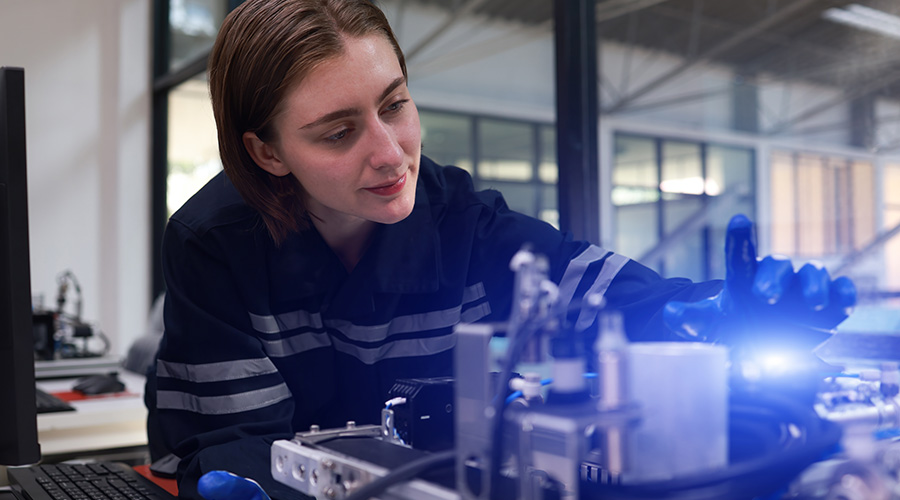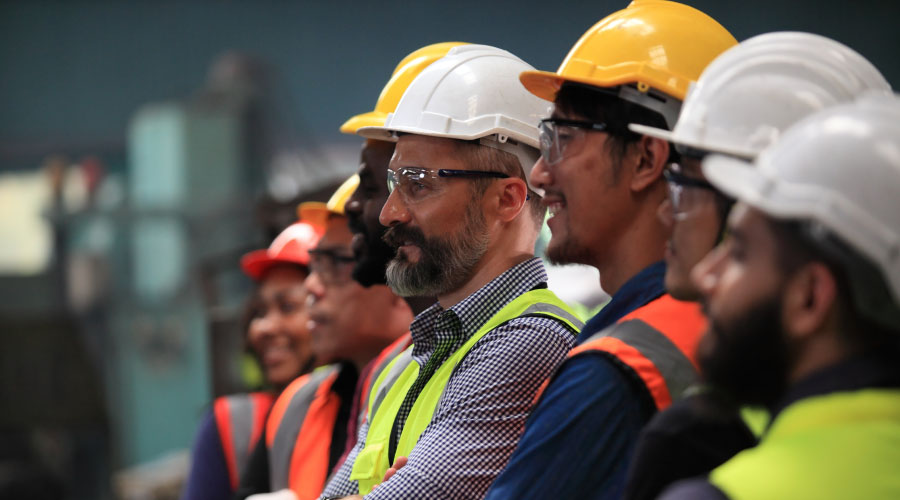Managers Discuss Sustainability Efforts
By Dave Lubach, Associate Editor
OTHER PARTS OF THIS ARTICLEPt. 1: This Page

Sean Devaney
District Director of
Collegewide Maintenance,
Broward College,
Davie, Fla.
|

Gary Wright
Executive Director of
Schools Operations,
Cherokee County (N.C.) Schools
|

John Lawter
Associate Director,
Plant Building and
Grounds Services,
University of Michigan
|
Sustainability remains high on the priority lists of most maintenance and engineering managers in institutional and commercial facilities. From product specification to technician activities, efforts to minimize the environmental impact of facility operations affect almost every decision managers make. In this roundtable discussion, managers share their insights on sustainability efforts in their departments.
Question: How has the commitment to sustainability redefined your role as a manager?
Lawter: I have always had a commitment to environmental sustainability and have fortunately been able to translate that to actual programs thanks to my responsibilities managing grounds, waste management, recycling, and custodial operations. In my 30 years in facilities operations, I’ve always had grounds and waste management responsibilities. That’s where I started. My first role as a plant director was I helped kick off the recycling program at Ohio State when I was there. That was probably the first big deal, and that was in 85, when these programs were still in their infancy, and the changes in landfilling with yard waste hadn’t taken effect yet. That was my first effort in trying to do something. It was student-run and we used student volunteers back then. I’ve always had that environmental bent to me. We tried pest management here, and also with my grounds group, using ladybugs to take out aphids. We’ve experimented with different kinds of fertilizer, soybeans, composts up here. When I got into the buildings services side of the world, I was moved indoors, and that’s when we introduced this operating custodial program that hugely reduced our chemical inventory. We were trying out things, and it was remarkable, where people were feeling that the air was cleaner and they were feeling healthier.
Devaney: I have been very much involved in sustainability initiatives since coming on board 11 years ago, serving on the sustainability committees at both the local campus and collegewide level. It was a great opportunity from the beginning to interact with students, faculty and staff throughout the system, and learn from each other. I immediately began to infuse sustainability initiatives into my planning process and relating it to all that I do. I once asked a group during a staff development training session, “What does sustainability mean to you?” So many related it to recycling. I was a bit surprised at that. So for the next hour we discussed sustainable initiatives. Recycling is much more than paper. We recycle lamps, batteries, engine oil, carpet, construction building materials, furniture, equipment, vehicles, to name a few. There is a sustainability policy associated with every department, from construction and design, procurement services, facilities, landscape and grounds, on through the academic programs. Planet, people and prosperity; relate one of the three, or all, in every business decision made, and you have a successful sustainable program.
Wright: The school district has received budget cuts from the state government for the last five years. Therefore, as operations director, it is my job to constantly find ways to save money to maintain services at the pre-recession level. We implemented a behavior modification program by contracting with energy education — renamed to Cenergstic. The energy manager met with small groups, PTAs, and community organizations to explain the goals and objectives of our energy program. Schools competed for the top energy prizes and the right to be named number one in their category for one school year. In better times, savings were used to reward the schools by providing a savings check to the school during the opening day ceremonies.
Question: Where has sustainability had the greatest impact on your department?
Lawter: Most recently, in our custodial operations with green products and chemical inventory reductions. We focus on cleaning for health where the safety of our staff and building occupants is the priority.
Wright: Energy costs savings has been the main input for savings for the last five years. Electricity, propane, water and sewer costs have been cut by more than 30 percent. We have converted three of our school’s facilities from a cathode fluorescent lamp (CFL) lighting format to a 100 percent light-emitting diode (LED) format. All incandescent and CFL bulbs throughout the district have been replaced with LED bulbs. In many schools we had a duplication of heating systems with electricity and propane being used in the same building. The district eliminated the propane systems and upgraded the boiler system to cover the increased heating capacity. The district has reduced water costs by watering athletic fields from 3-6 a.m., and by pulling obsolete meters that were not being used by the district.
Devaney: In my role, sustainability has impacted every aspect of operations, such as replacing the collegewide vehicle fleet with new, fuel-efficient models. This not only impacts maintenance and fuel costs, but is a branding issue, providing a positive image to the college and outside community. Many landscape projects are under way using Florida native and drought-tolerant, non-invasive exotic plants. By college policy, we are limiting sod use and reducing water consumption. Two energy directors are on staff full time, evaluating energy use, performing audits, working with local municipalities, utility companies, and educating the campus community. The projected savings forecasted will fund the positions. There is an LED pole light replacement program underway collegewide, and in discussion is a proposed LED replacement program for classroom lights. A chiller-system cooling tower and well water make-up installations are saving millions of gallons of water each year, and high-impact glass installations are protecting assets and reducing energy costs, and we are installing electrical meters in all buildings to track building utility costs and additionally, for educational purposes, through electronic dashboard displays. I think it is fair to say that sustainability has impacted all aspects of facilities management.
Question: What challenges have you have found regarding sustainability?
Devaney: The biggest challenge is finding the financial resources and prioritizing effectively. Currently, I have three condition assessments underway, looking at collegewide roofing systems, elevators, and building envelopes. The overall assessments will allow for appropriate prioritization of funds to address needs. All three have sustainable components, for example: installation of cool-top roof systems and coatings, use of energy efficient motors, controllers, LED lighting for elevator renovations, and installation of high-impact glass, waterproofing buildings, and reducing overall energy cost.
Lawter: Balancing the requests and energy around new programs and technologies with financial reality. Like anything, you have to do a little return on investment analysis. The thing we’re working on now is trying to get a good food waste program. That’s been problematic that it takes some serious infrastructure to make this happen. How do you get the critical mass and the upfront funding and the interest from the university to invest in something like that, knowing that the long-term gain would be great but right now it’s just cheaper to keep throwing everything away. It’s hard to fight that mindset of not being just a disposable society since financially it’s the cheaper way to go. In grounds, challenges we’ve tried to introduce natural gas vehicles on campus. We moved our hand mowers from 2-stroke to 4-stroke, which really helped. It’s a much cleaner exhaust, even though it’s not perfect. We experimented with electric vehicles, but those didn’t pan out. They just didn’t have the power in the wintertime, you could either run the vehicle or you could run the heat, but not both. Then we tried some alternative fuels, biofuels and things, which worked OK. This natural gas, the best thing is the only byproduct is water vapor, burning natural gas versus gasoline or diesel. We looked into it but we had no filling stations to fill up. There were two spots in Ann Arbor and it was going to be a huge investment for our bus garage, for gas-filling stations. It’s another financial roadblock that has a huge environmental impact.
Wright: The major challenge on sustainability for our department is locating additional financial resources to continue the infrastructure upgrades in all energy areas. The operations department has a goal to convert as much of the CFL lighting infrastructure within the district to a 100 percent LED format as quickly as possible. Cherokee County is a Tier 1 economically distressed county, which means locating local funds is almost impossible. Therefore, we have submitted applications to some of the largest foundations with a track record with environmental issues. We have asked them to provide “transformational funding” for one or two schools within the district. Our grand experiment of changing our alternative high school to LEDs proves that the potential energy savings for the U.S. just with the schools alone — it could make America energy secure as well as reducing the CO2 footprint.
Question: What impact does sustainability have on your staff?
Lawter: Mainly an increased awareness of the issues and challenges involved in creating or not creating sustainable systems. When we do programs, we try to get the staff involved in the planning process, but sometimes it happens where you say hey, this is what you are going to do now when you used to do something else, and they are like, “What for?” In some cases it might be some extra work, so we have to go back and explain the environmental benefits that are going on. And through that process, saying it’s a scarce resource. In Michigan in particular, people don’t realize what a valuable and scarce resource clean water is. We’re surrounded by 20 percent of the world’s fresh water supply, so they don’t get that. They don’t realize that most people in the world don’t have access to fresh water. That’s a big education thing for them where they wouldn’t be exposed to it or even think about it unless they were involved in the program.
Devaney: Staff members are trained to think sustainability. It is everywhere throughout the system, from the college president, board of trustees, college administration, students, faculty and staff. It is part of everyday culture on campus.
Question: Describe a sustainability effort that has paid dividends for your department.
Wright: We worked with the Tennessee Valley Authority to develop a 0.999-megawatt solar farm at one of our elementary schools. We receive a substantial credit each month, which reduces the overall energy bill.
Lawter: We have many initiatives, but there are three that have had the greatest impact. The first is our winter deicing program, which reduced the amount of salt spread on campus by 40 percent over a 15-year timeframe and eliminated sand as a deicing material. The second, funded through a grant, created a central control system for our 100-plus irrigation systems and has realized a 68 percent reduction in campus irrigation water usage. Third, a new custodial operating system we implemented, reducing our chemical inventory from 50-plus products to less than a dozen. Two of the three daily-use chemicals are green certified.
Devaney: The greatest sustainability effort collegewide is the creation of campus based sustainability committees. They open doors to discussions and ideas that lead to new initiatives, standards and policies. The committees are made up across all disciplines and include the student body. Many great events are planned, such as Earth Day celebrations, Environmental Week, film showcases, and recycling initiatives to name a few. There is nothing more satisfying than to see people in the campus community come together and get involved.
Question: What is the next step your department plans to take increase sustainability?
Devaney: Broward College is growing, with upwards of 70,000 students. The biggest challenge I am faced with is to provide clean, environmentally pleasing, comfortable and safe environments conducive to teaching and learning. The focus of our department is to maintain and upgrade existing facilities, remove from inventory those that have served a useful life, and construct new environmentally healthy buildings. There are many projects underway collegewide that focus on all of the above initiatives. All of our major renovations and new construction projects meet the U.S. Green Building Council LEED certification requirements.
Wright: We are actively seeking grants to convert our school district into the first 100 percent LED district in the nation. We have already converted three of our facilities and have seen a significant reduction in electrical consumption.
Lawter: (We are) continuing our efforts to reduce landfilled waste and close the recycling loop. This was a hot topic when space was an issue. It relaxed somewhat once we properly managed our yard waste, but is coming back with post-consumer food waste programs and new technologies.
Related Topics:














